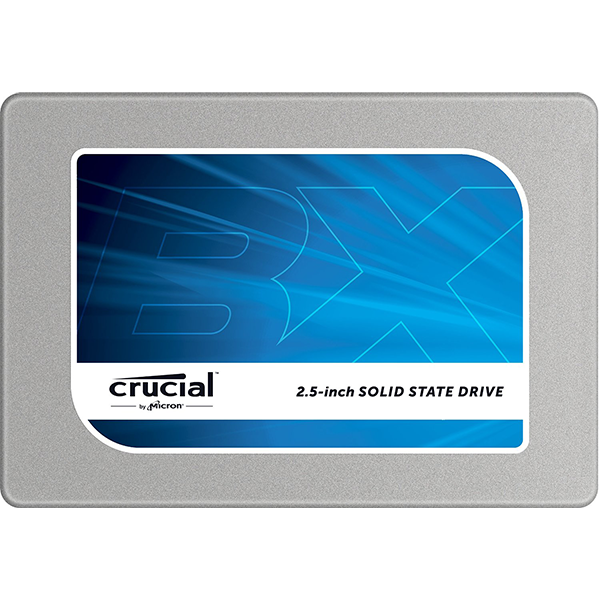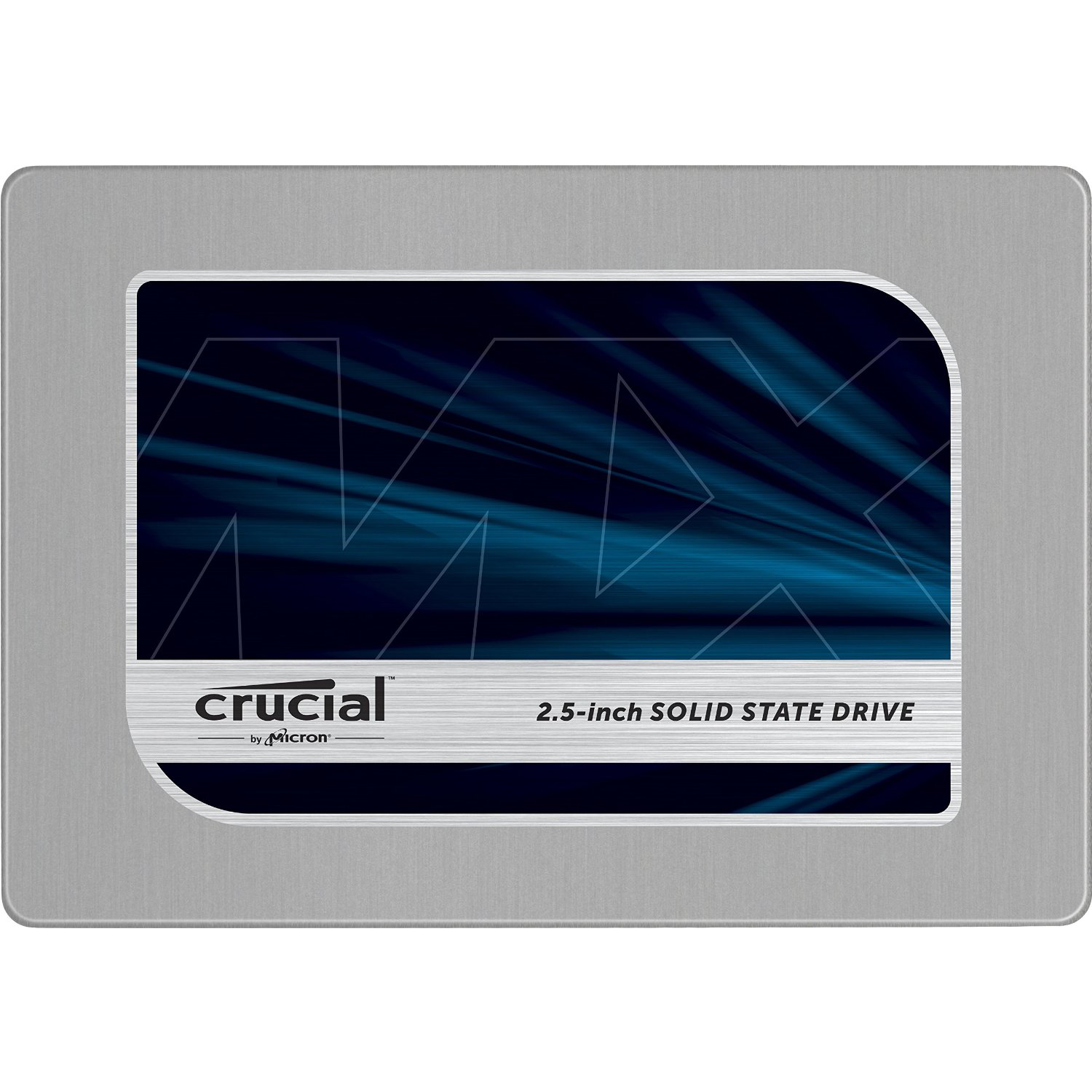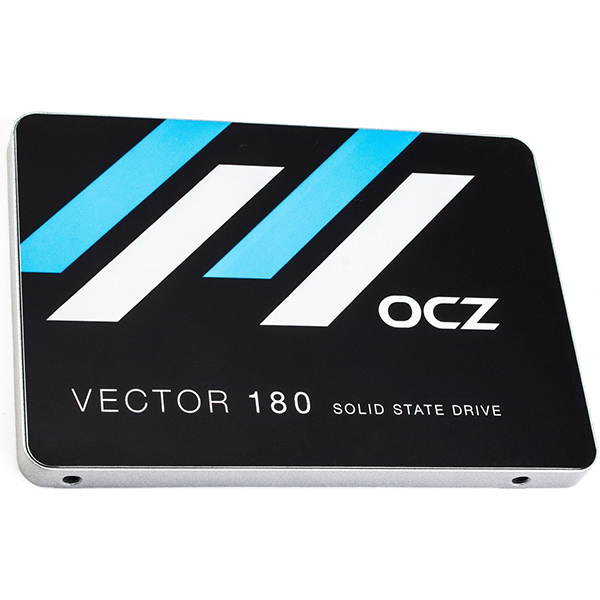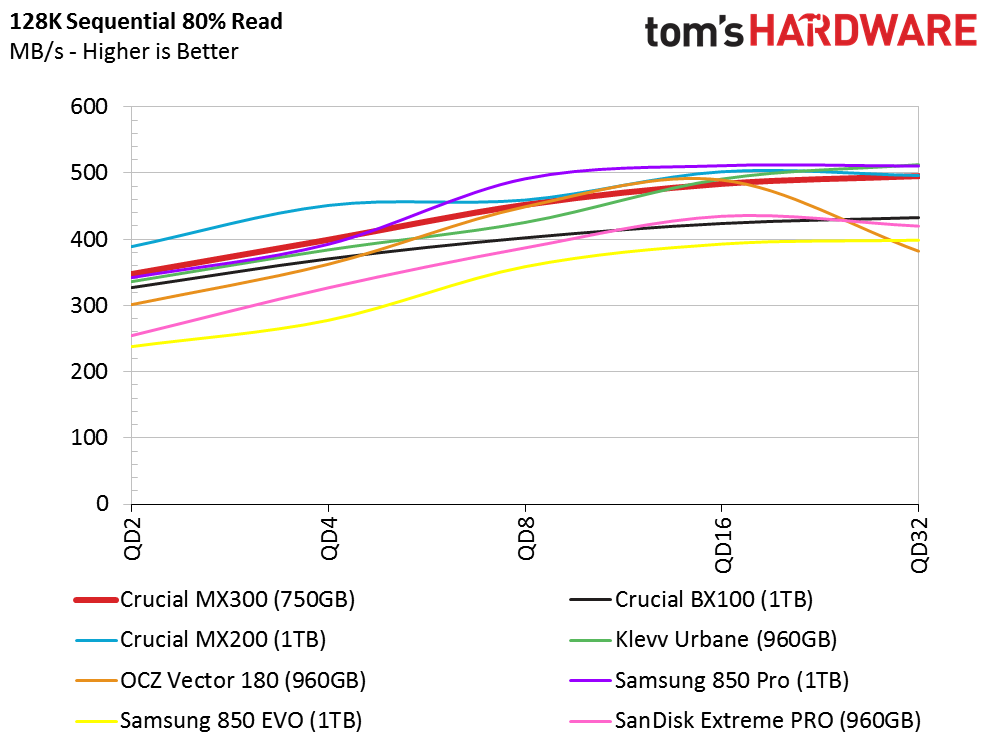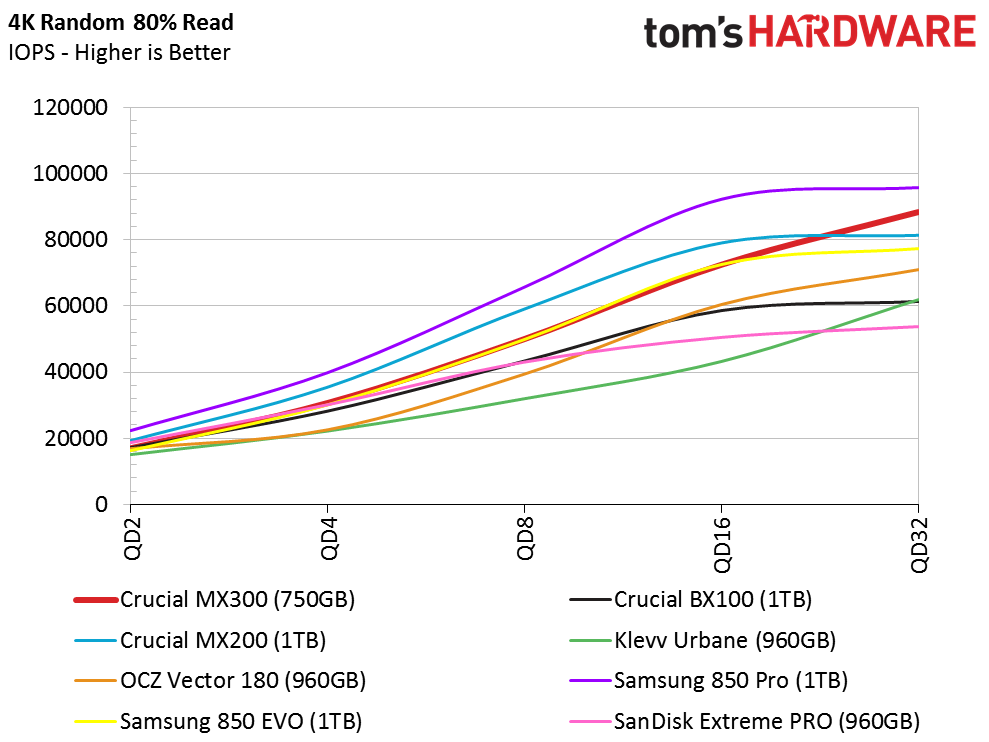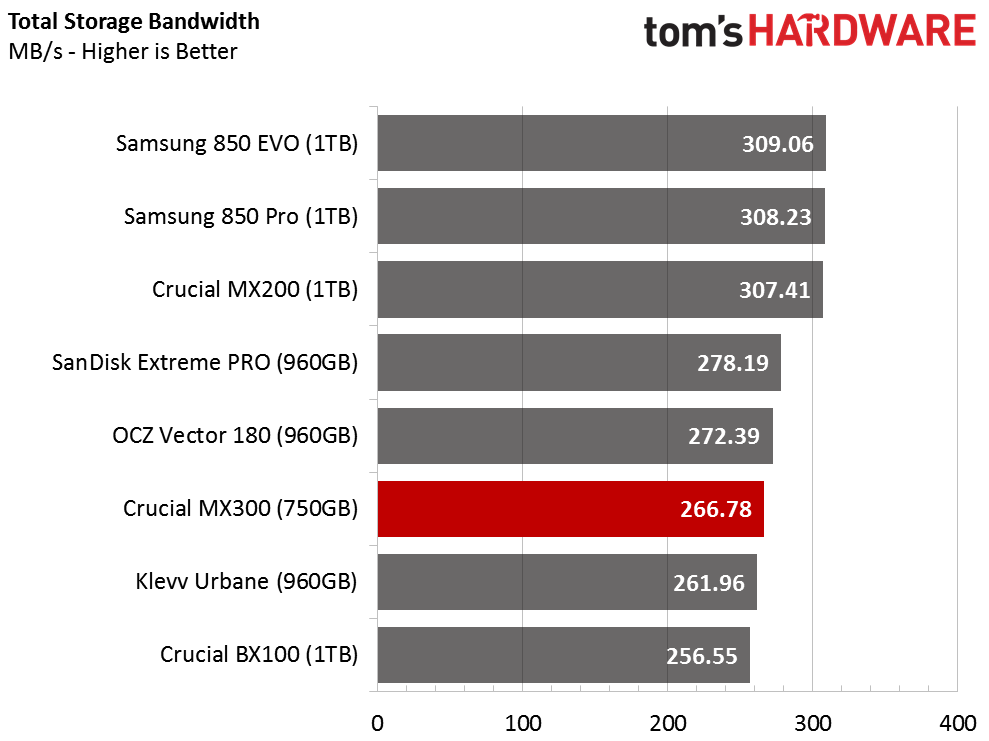Crucial MX300 750GB SSD Review
Micron's new 3D flash comes to market first in a limited edition MX300 750GB SSD. The new drive joins Samsung's 3D with TLC in the mainstream category.
Why you can trust Tom's Hardware
Benchmarks
Comparison Products
The recently announced TX3 from Ballistix (By Micron) becomes the company's new top shelf SSD, while the MX series addresses the mainstream segment. We built charts with both categories to compare performance between them. Industry favorites like SanDisk's Extreme Pro and Samsung's 850 EVO are present, as are older and newer competitors. The Klevv Urbane represents several Phison S10-based MLC products; it's one of the best SSDs we've tested with Phison's controller.
We're including two additional Crucial products in the charts. The BX100 with 16nm MLC NAND is still available, though it is subject to dwindling supply. It's much more competitive than the BX200 that ships with 16nm TLC NAND. You'll also find the MX200 in our charts. It's older, but we're obligated to include the MX300's predecessor, right?
Sequential Read
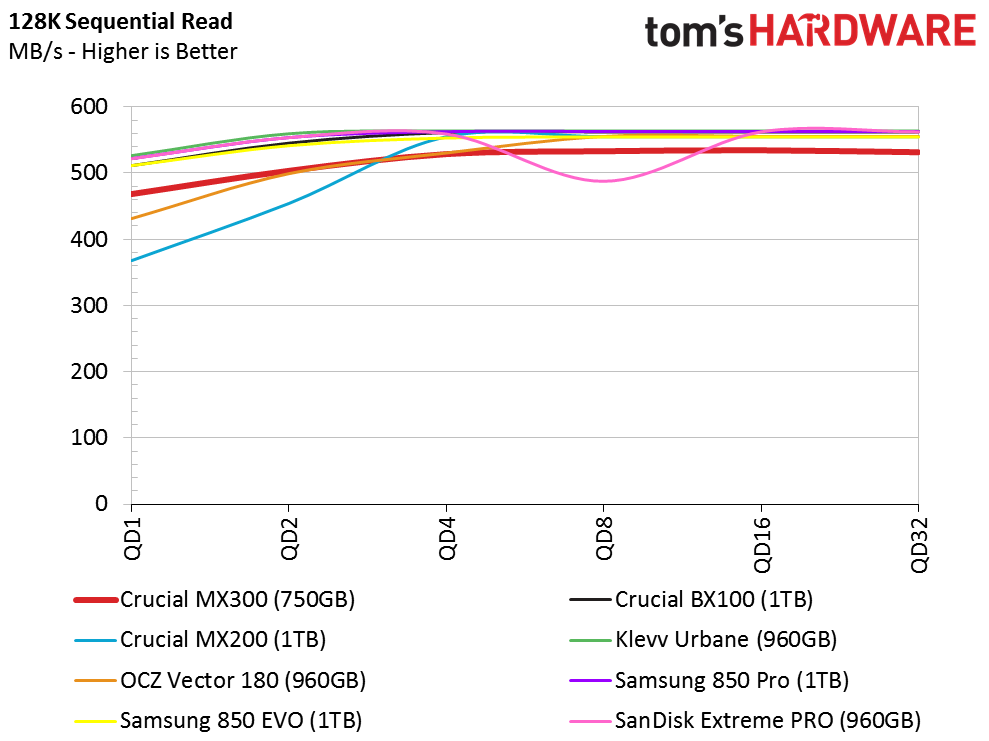
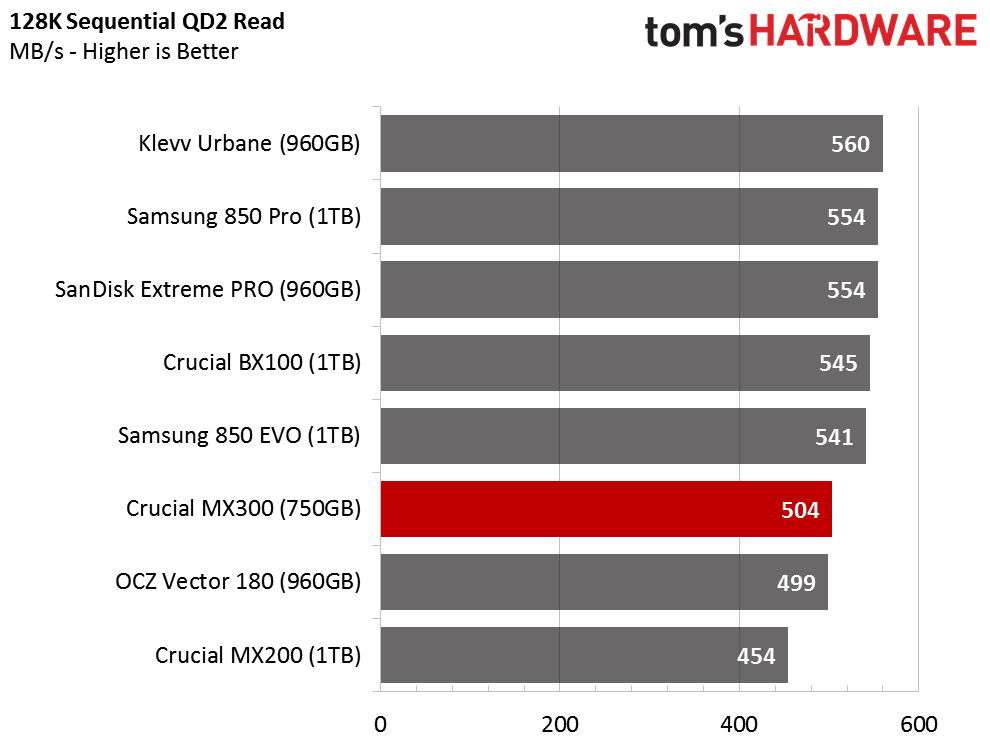
The chart plotting performance over queue depth shows two distinct tiers. The MX300 falls into the lower one, even though this is the easiest workload for modern solid-state drives.
The configuration we're looking at today is not impressive, even though the MX family was historically Crucial's premium model.
Sequential Write
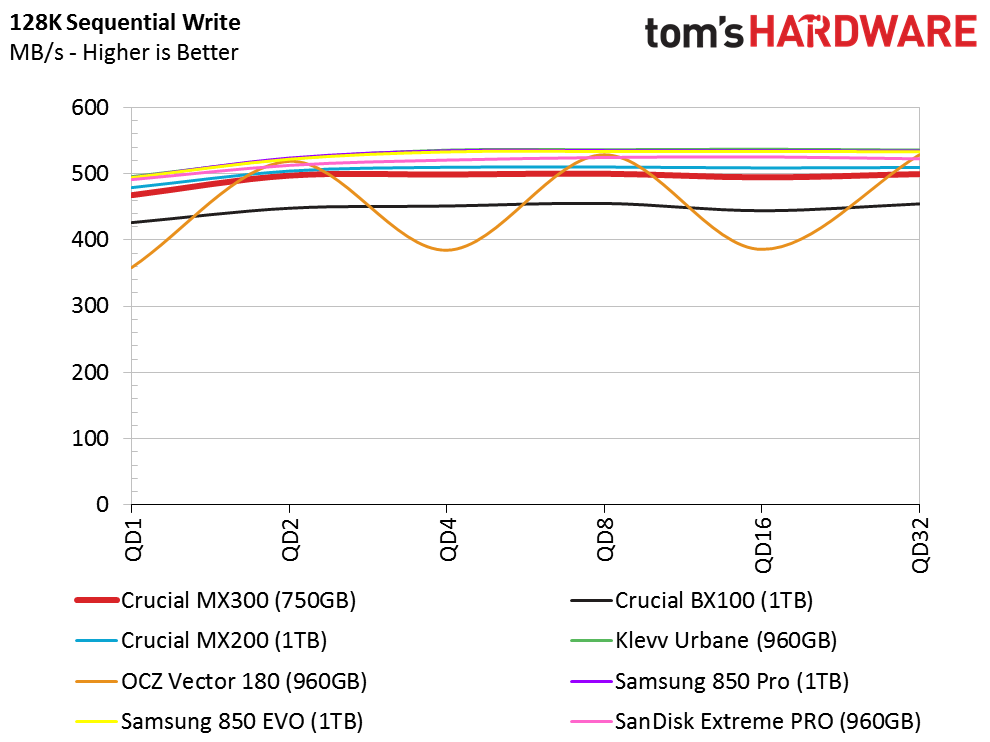
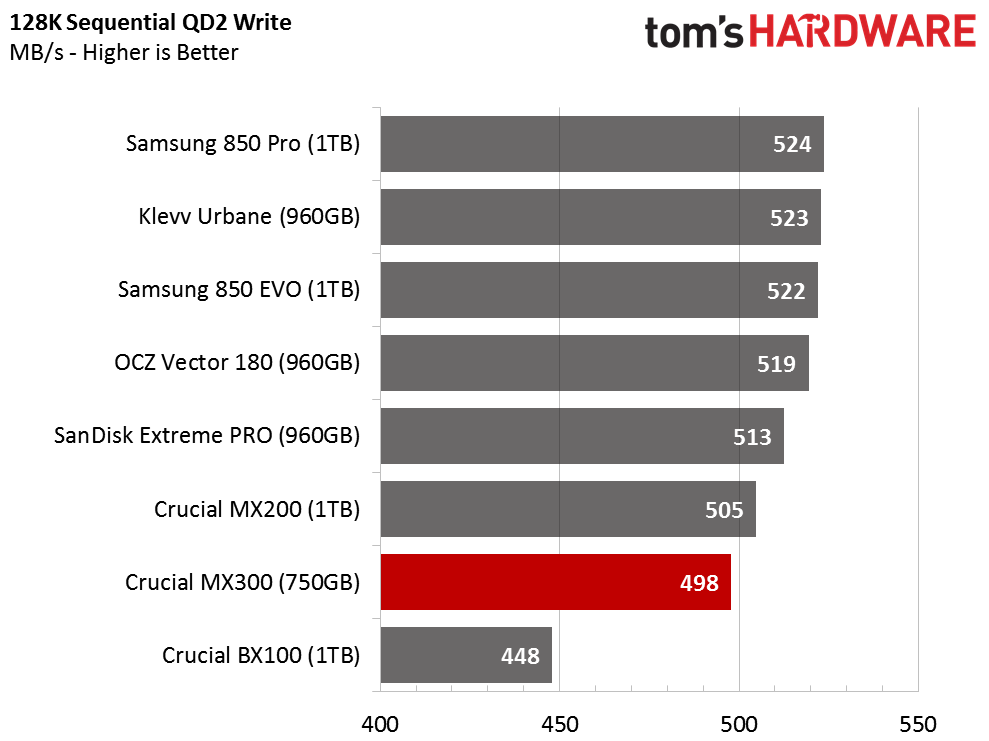
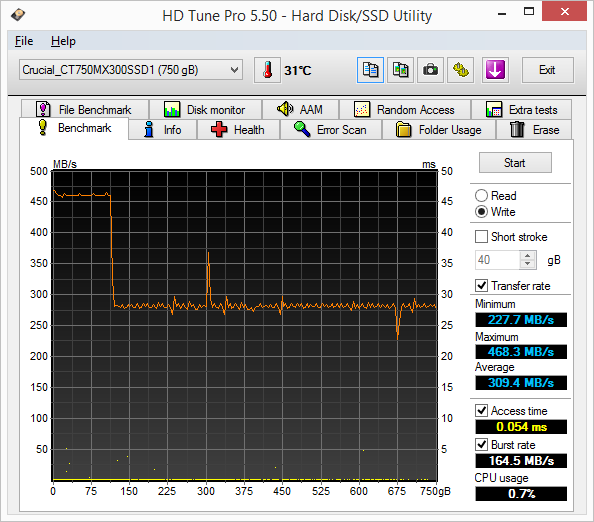
The MX300 750GB Special Edition trails many of the other products in sequential write performance, too. Even at higher queue depths, the drive has a difficult time breaking 500 MB/s. We expected a better showing with the new quad-plane 3D memory interface that increases performance. Samsung uses a dual-plane interface for V-NAND. The 3D NAND on-board the MX300 increases sequential write performance (beyond the emulated SLC buffer) over planar memory technologies from Toshiba and Micron, but it still trails behind Samsung's existing 3D TLC flash.
Our results indicate that the MX300 lags behind other 3D NAND-powered competitors, but we really need to see the new Micron 3D NAND paired with an eight-channel controller to make a fair comparison.
Random Read
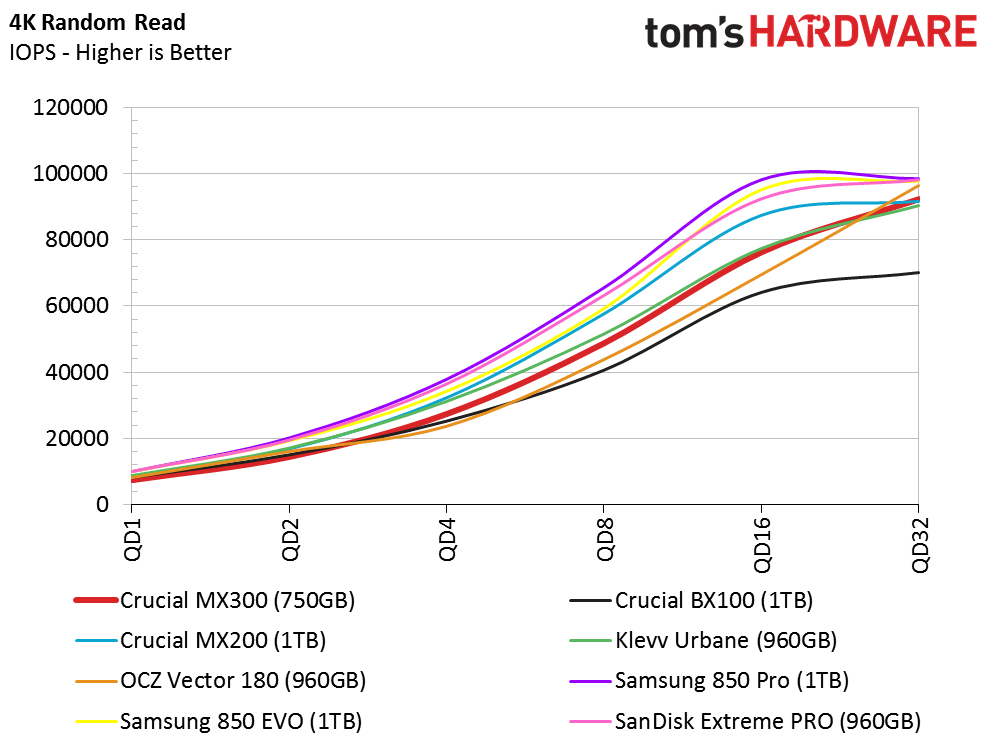
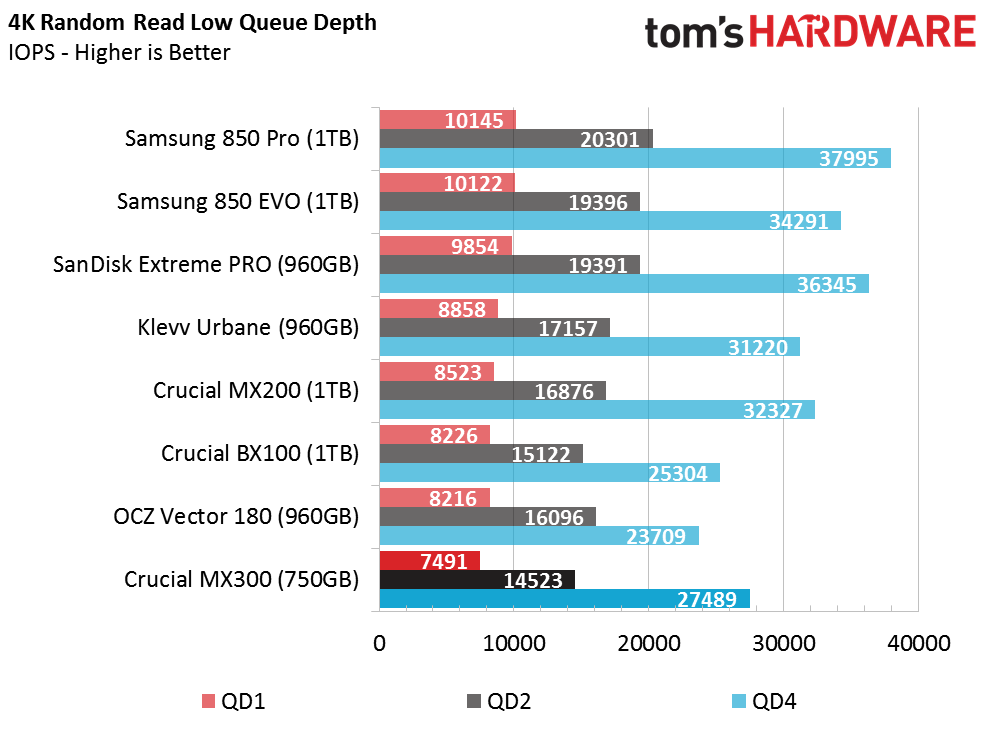
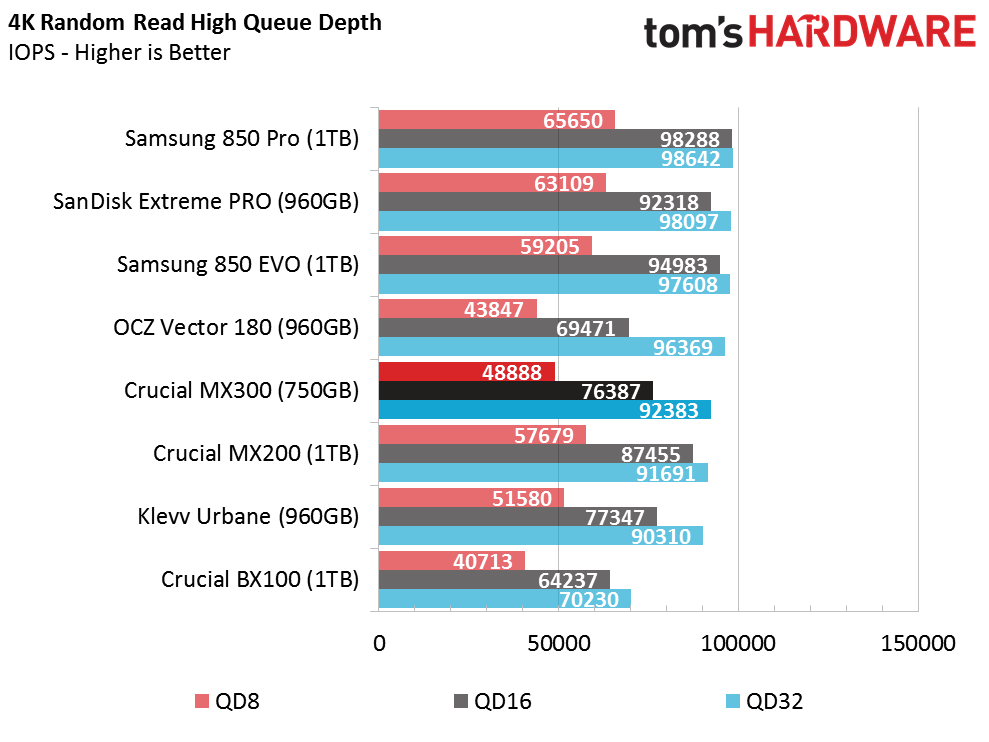
The MX300 750GB falls behind every other SSD in random reads at a queue depth of one and two. Again, we expected to see the quad-plane flash perform better than the planar flash on Crucial's aging BX100 and MX200, but that wasn't the case. Instead, performance falls to near-unacceptable levels for a mainstream SSD, though it's consistent with Crucial's steady slow-down over the past several SSD generations.
Get Tom's Hardware's best news and in-depth reviews, straight to your inbox.
Random Write
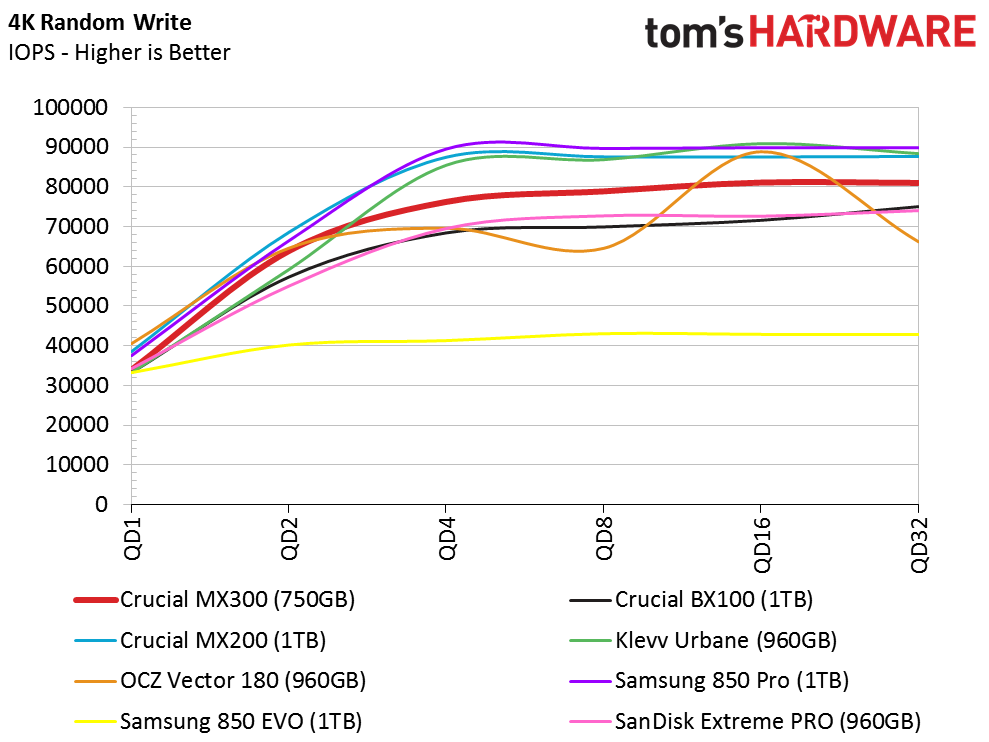
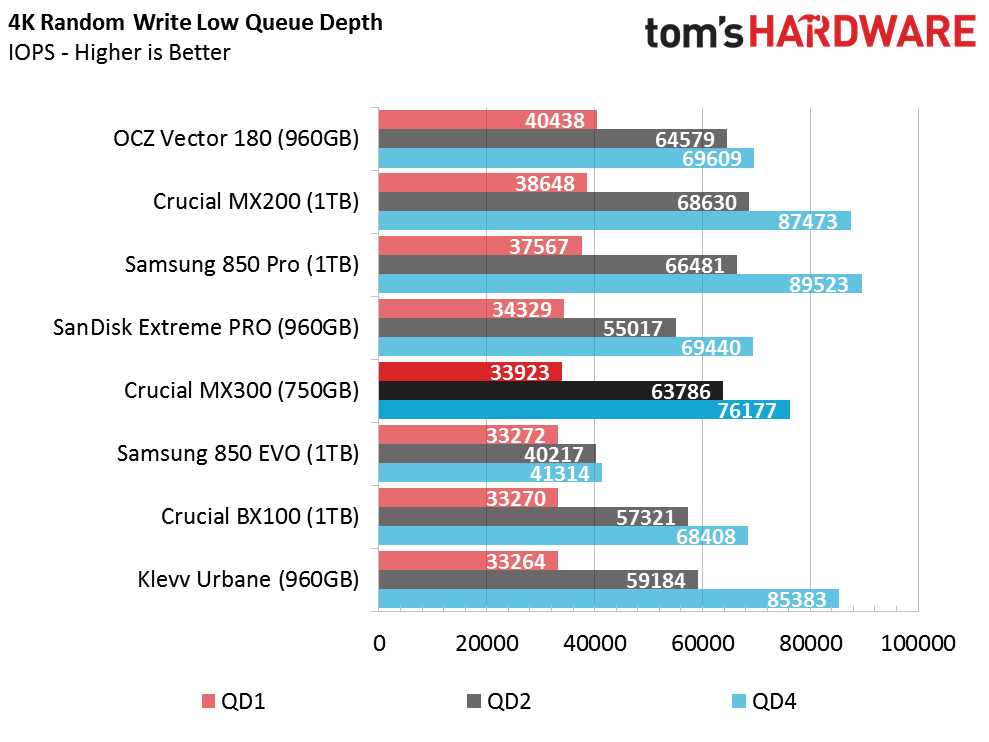
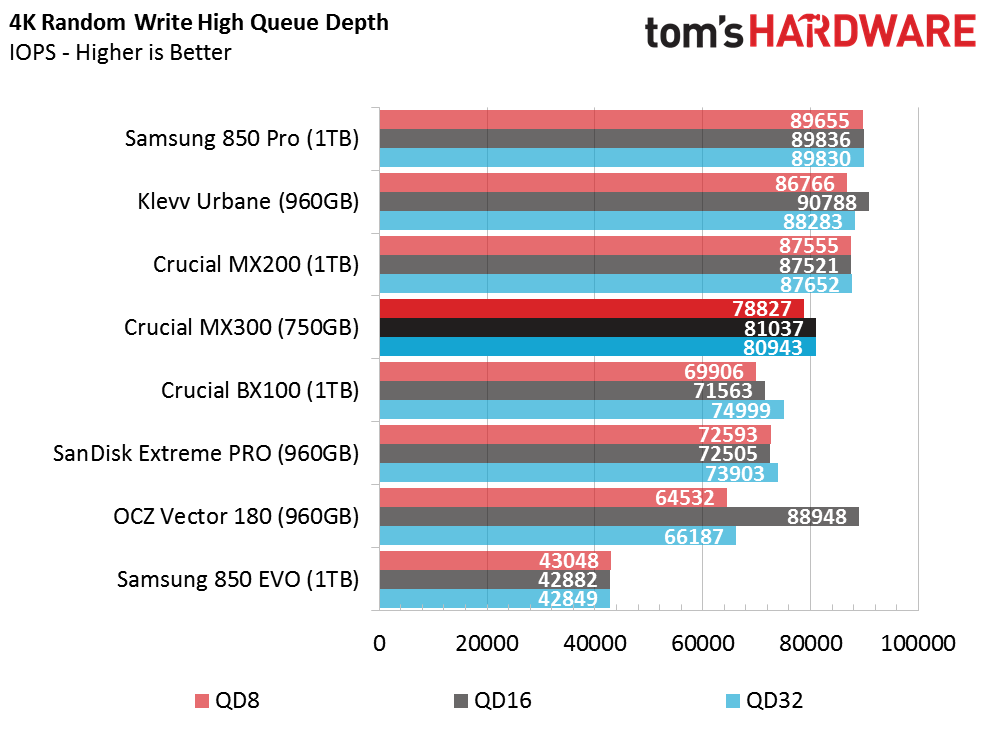
The MX300 fares better writing small blocks of data randomly, but it only achieves mid-level performance compared to other products in the charts. At least these results come closer to what Crucial told us to expect from the MX300.
80 Percent Sequential Mixed Workload
Our mixed workload testing is described in detail here.
Crucial originally planned to launch its MX300 one month ago. But after reviewers encountered inconsistent results, the company delayed to tune its firmware. The updated build improves mixed workload performance and lowers latency in some corner cases. Post-update, the MX300 does much better in this scenario, appearing as one of the most consistent drives in the test pool.
80 Percent Random Mixed Workload
Random mixed workload performance is also consistent, scaling well as queue depth increases. Two other products surpass the MX300 though, one of which is Crucial's older MX200. The MX300 delivers nearly identical performance as Samsung's 850 EVO in this metric.
Sequential Steady State
Our steady state tests are described here.
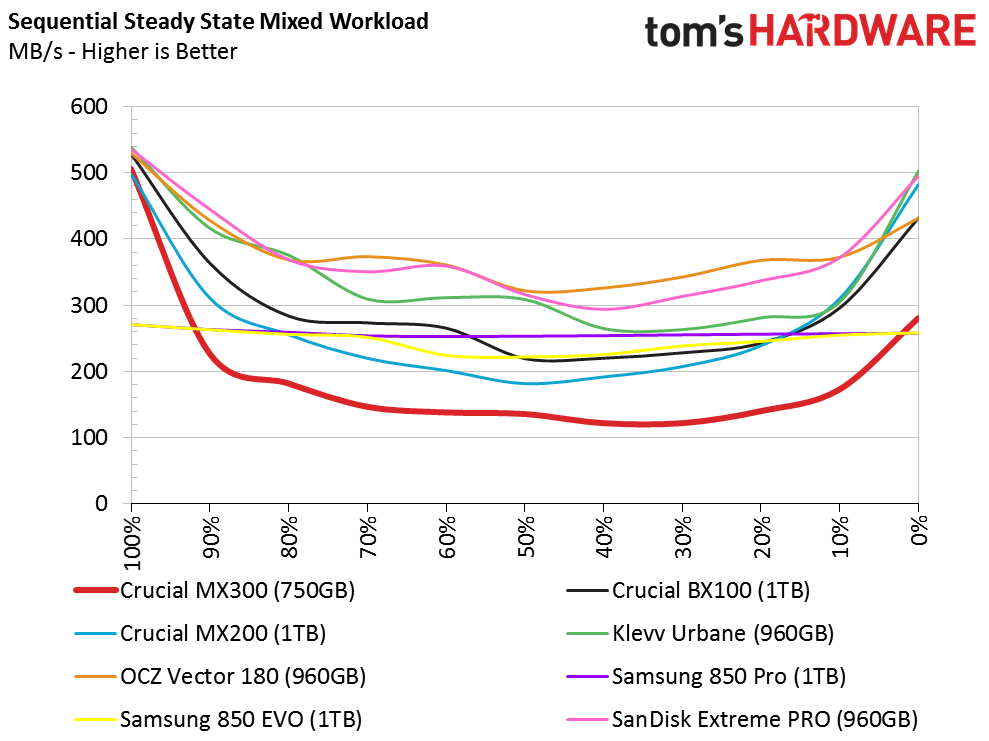
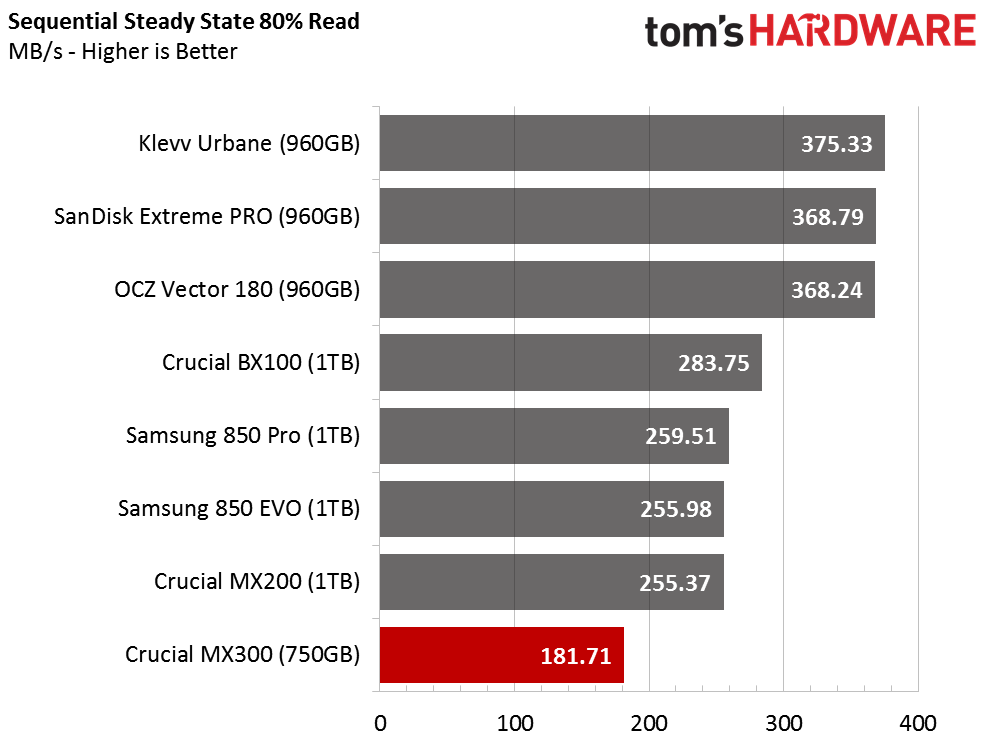
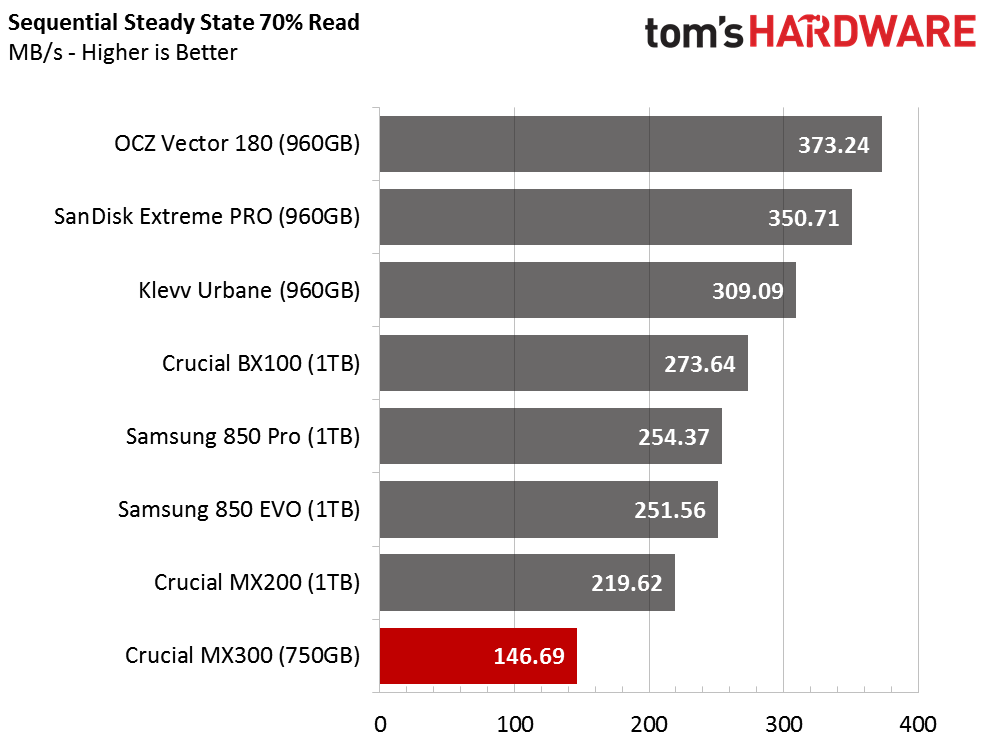
Even with its advanced 3D flash and admirable performance in our mixed sequential benchmark, the MX300 behaves poorly in the sequential steady state test.
Crucial's new drive does have a high endurance rating of 220 TBW, but we wouldn't recommend this product for heavy sequential write environments like audio or video editing.
Random Write Steady State
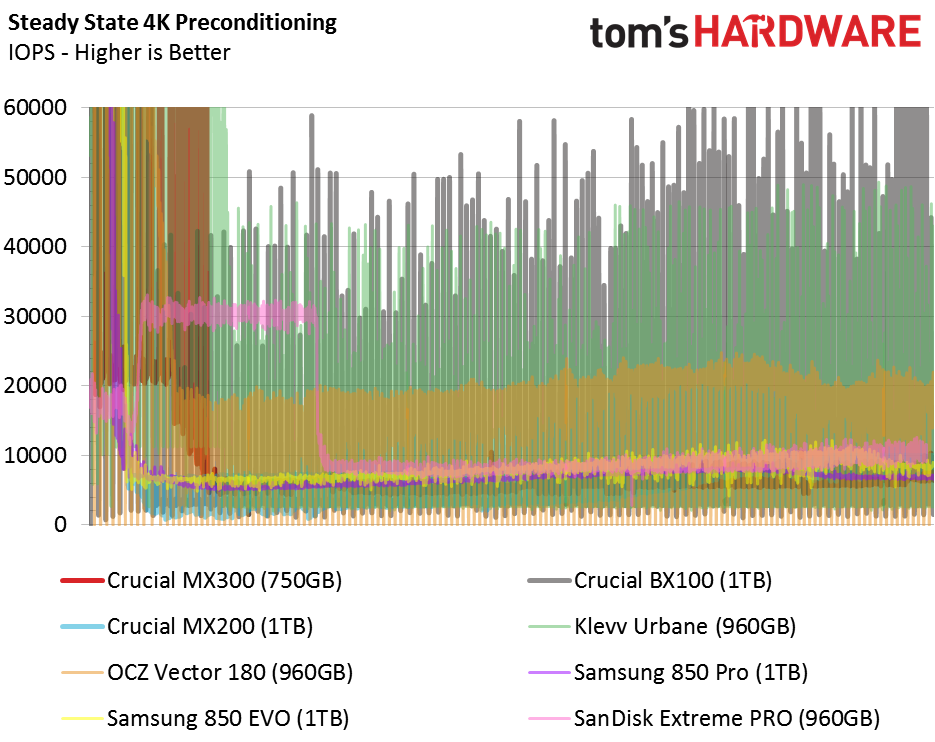
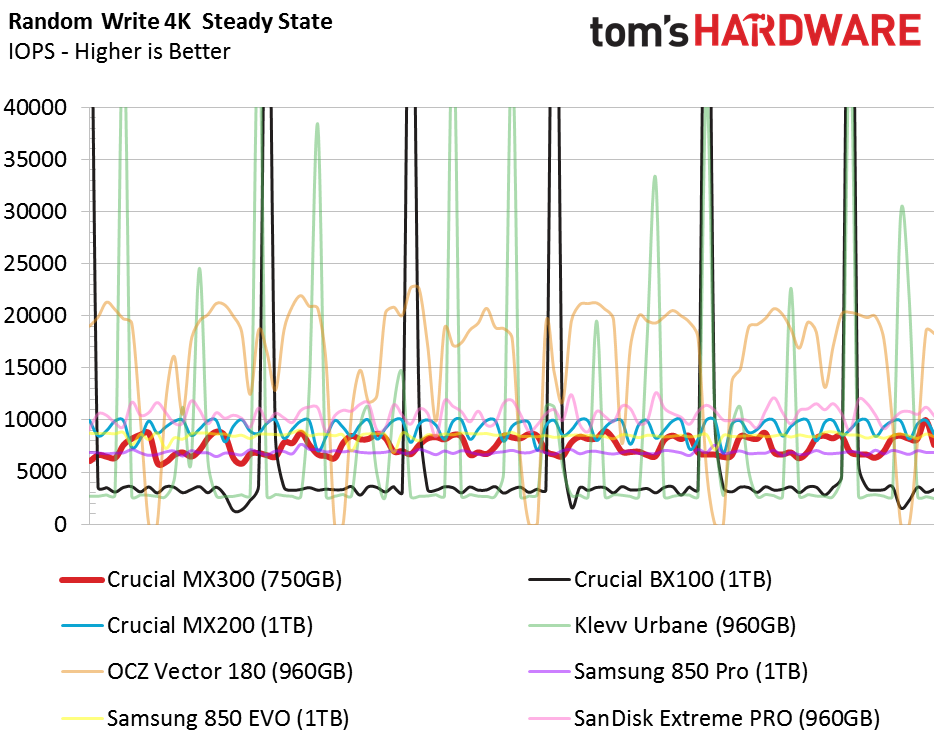
Random steady state performance falls below 10,000 IOPS, but remains fairly consistent compared to many of the low-cost TLC-based SSDs shipping today. Still, the MX300 is slower in this workload than the model it replaces. Crucial's MX200, as well as SanDisk's Extreme Pro, delivers higher and more consistent random performance, which is better for RAID environments.
PCMark 8 Real-World Software Performance
For details on our real-world software performance testing, please click here.
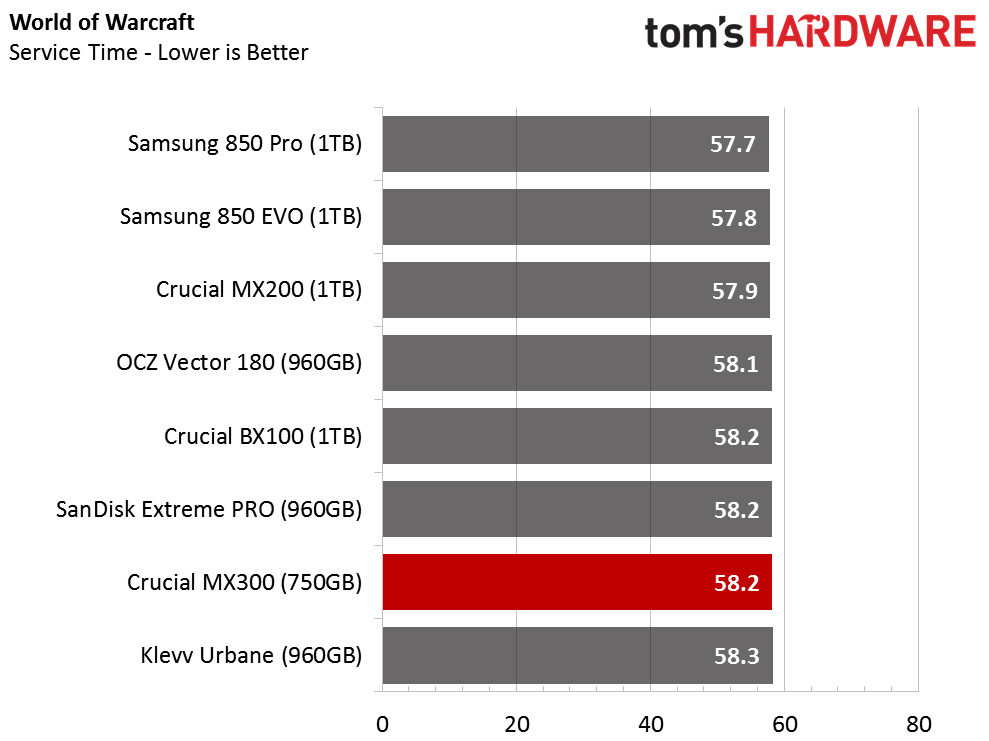
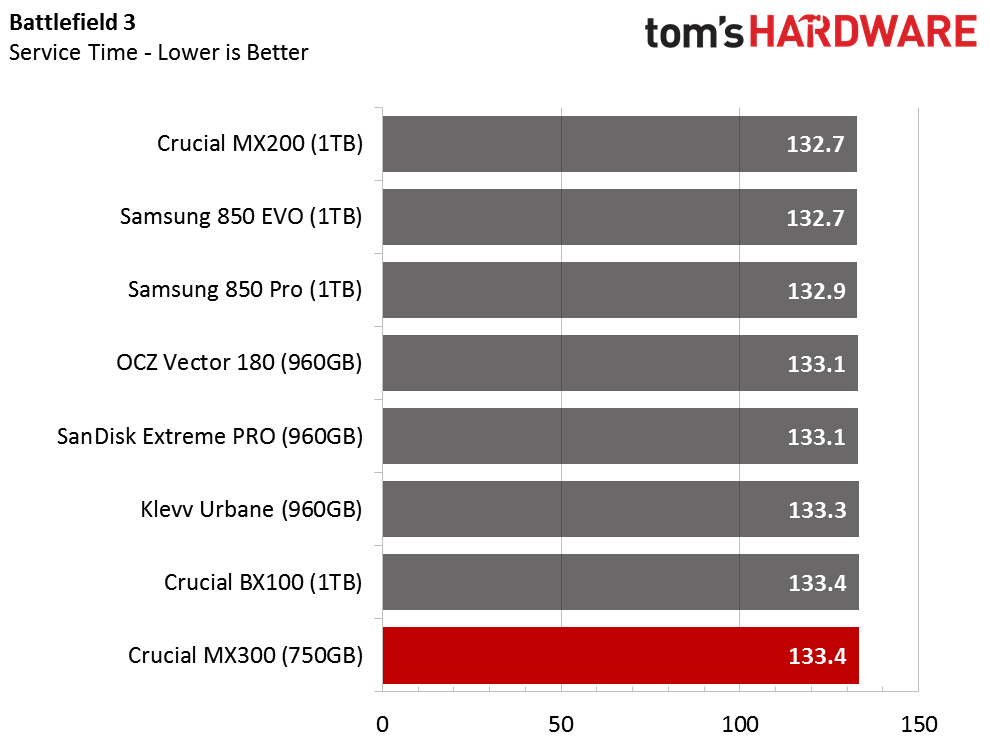

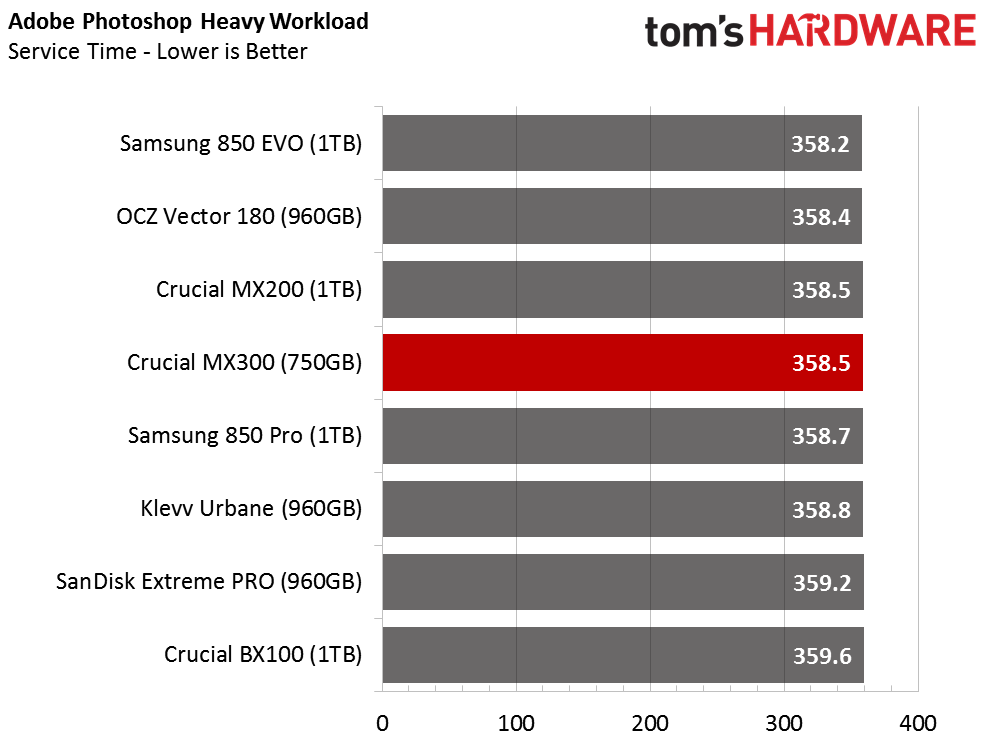
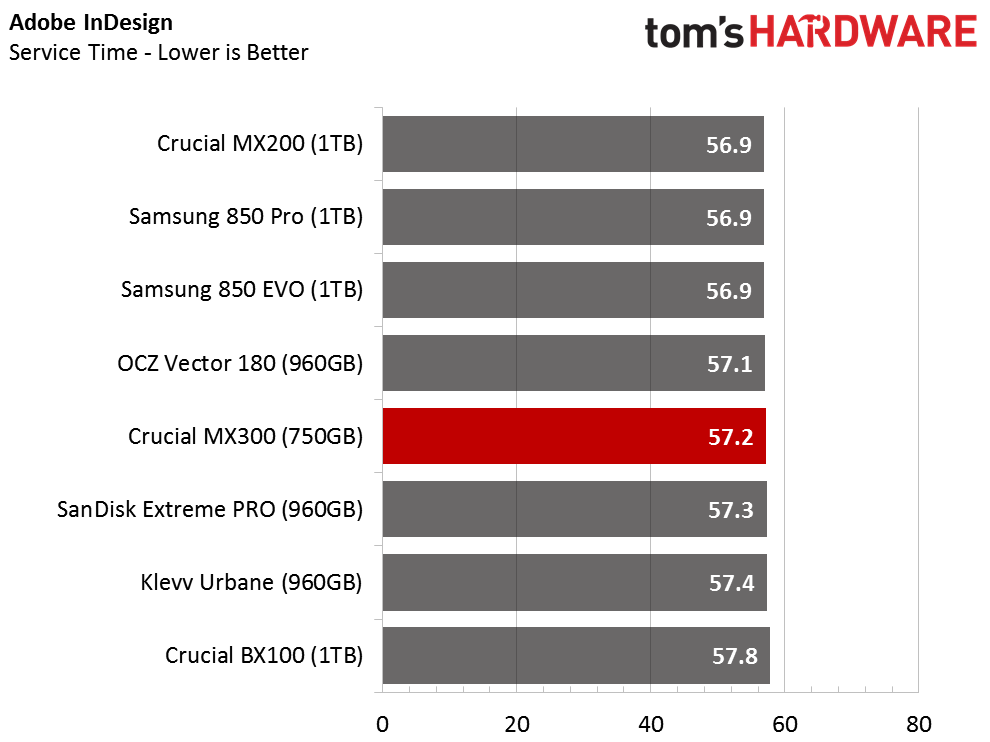
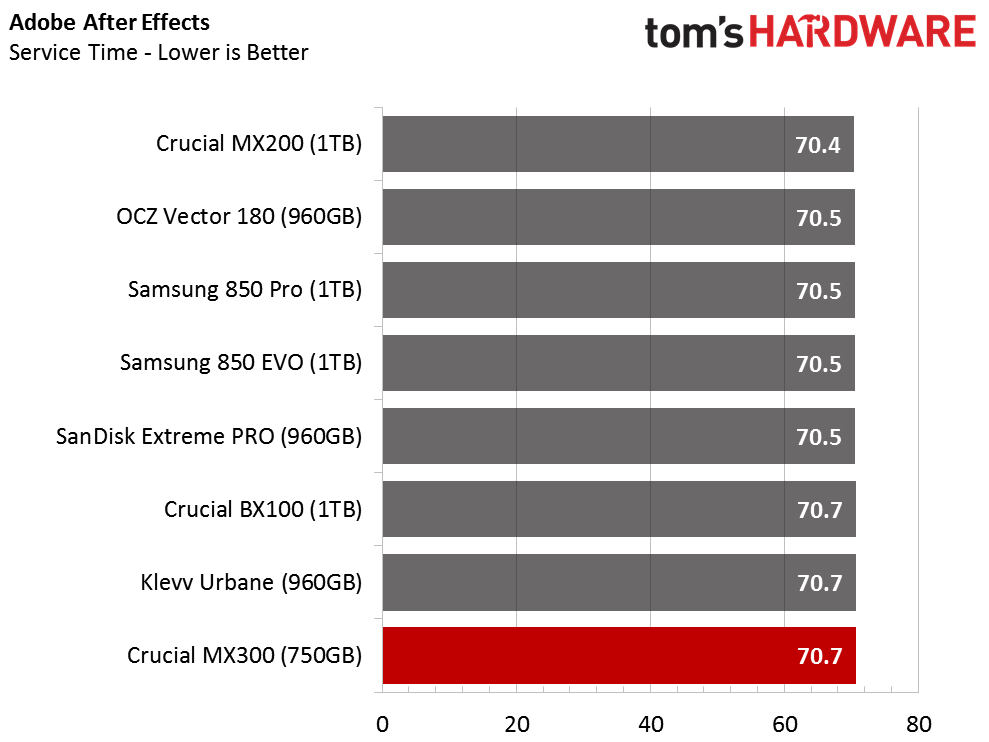
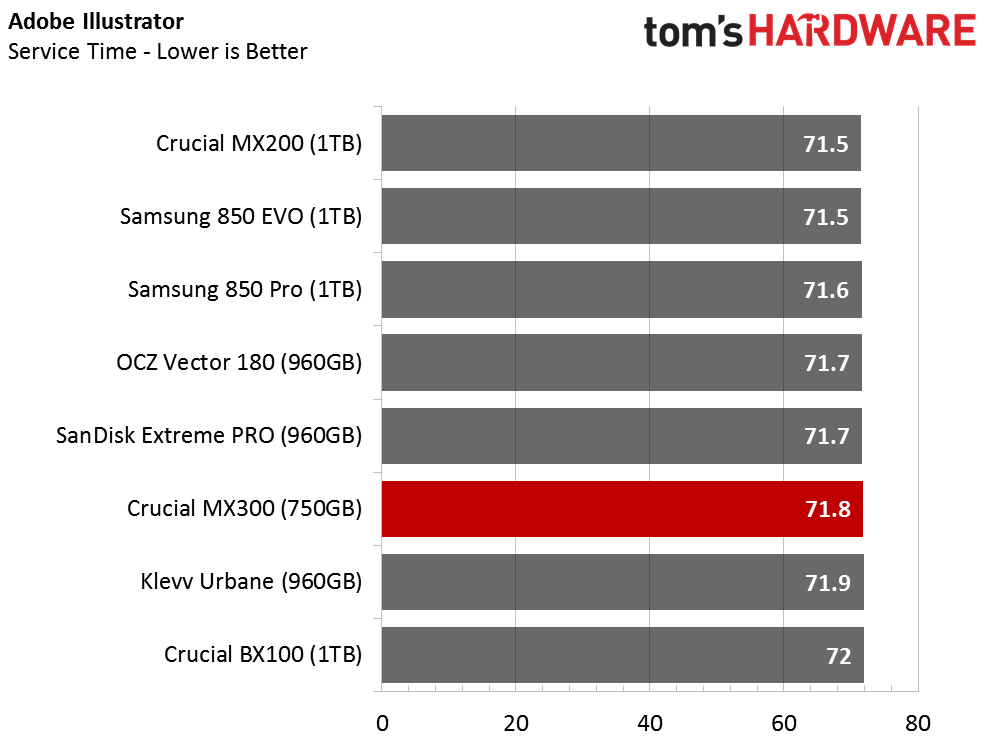
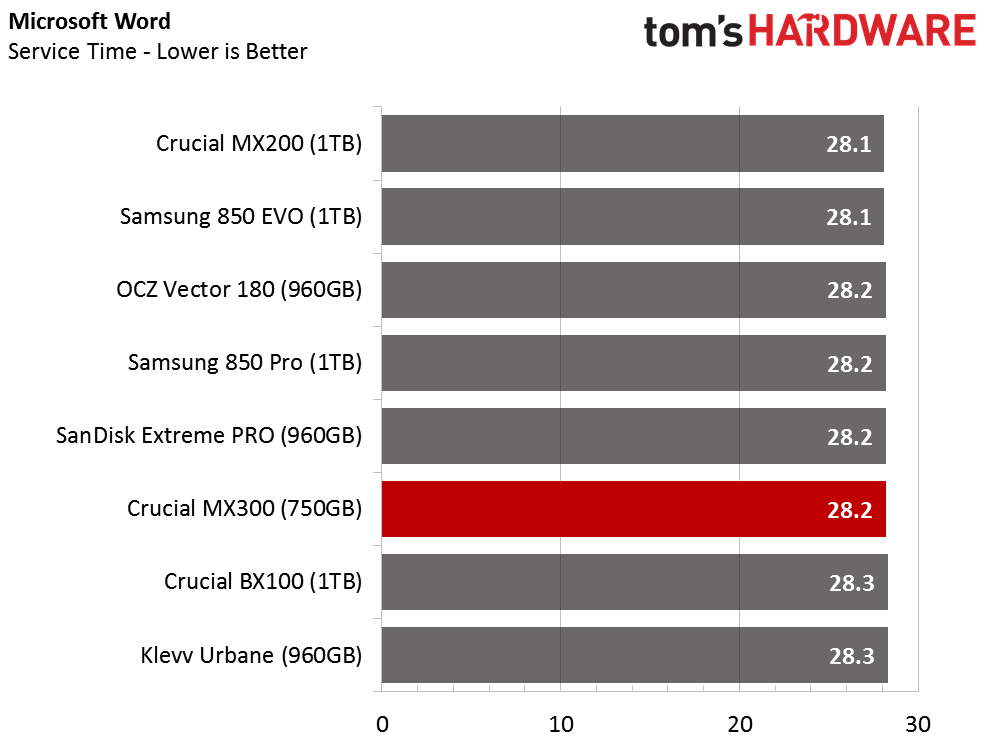
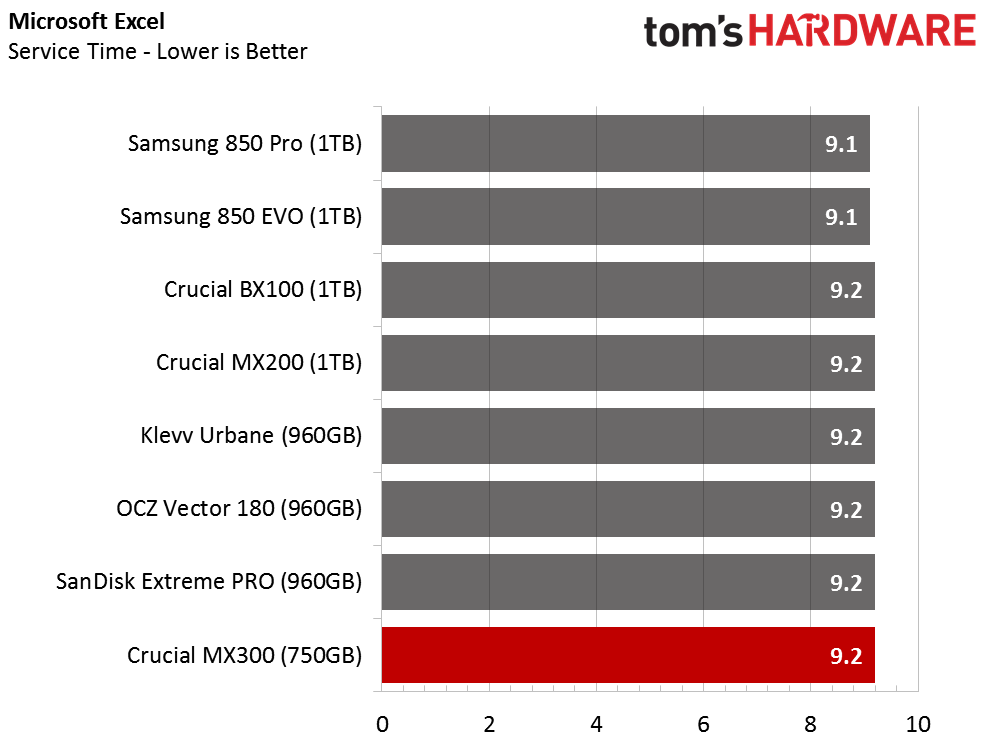
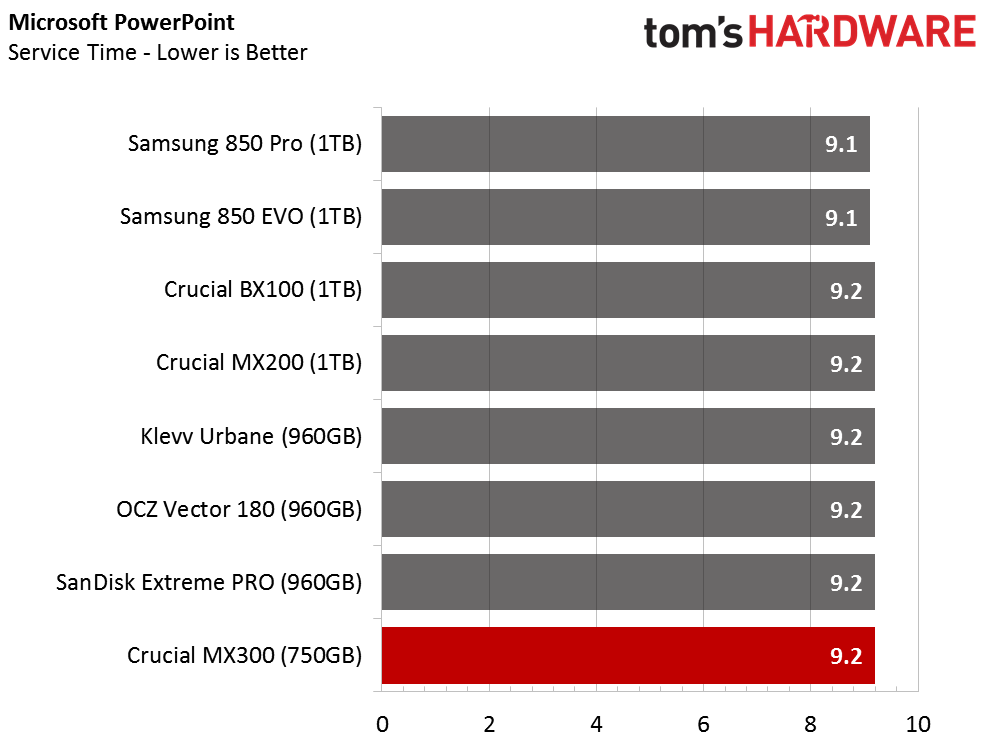
At first glance, the MX300 appears to trail most of its competition, but it actually matches the completion time of several other drives in each real-world task.
Total Storage Bandwidth
The combination of new 3D flash and Marvell's four-channel Dean controller proves to be significantly slower than the old MX200. The MX300 is only slightly better in real-world workloads than the BX100, which was Crucial's previous-gen entry-level model.
PCMark 8 Advanced Workload Performance
To learn how we test advanced workload performance, please click here.
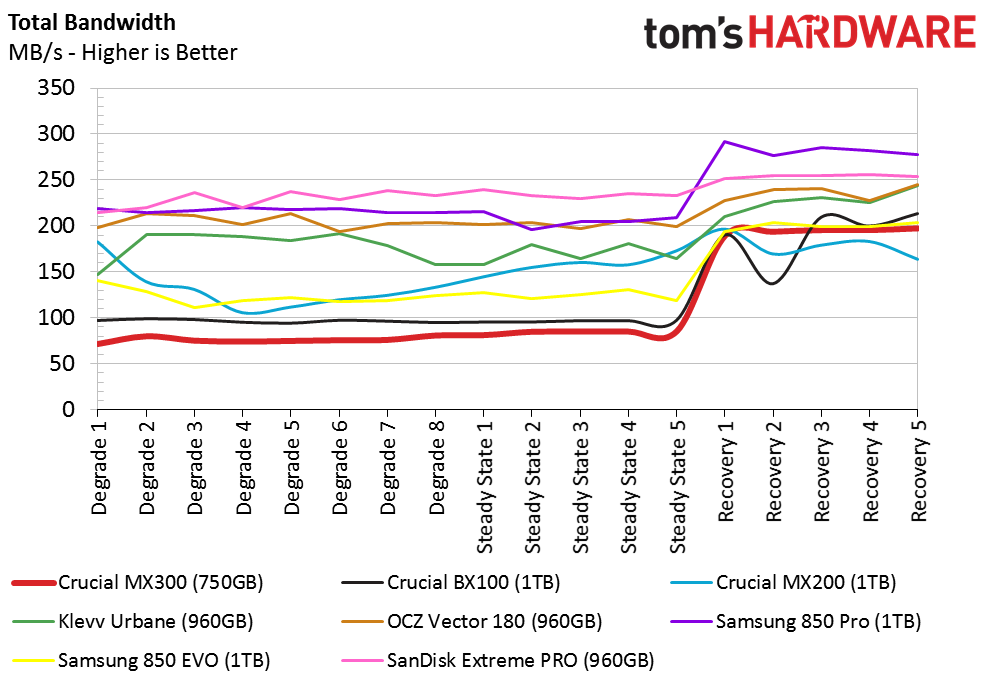
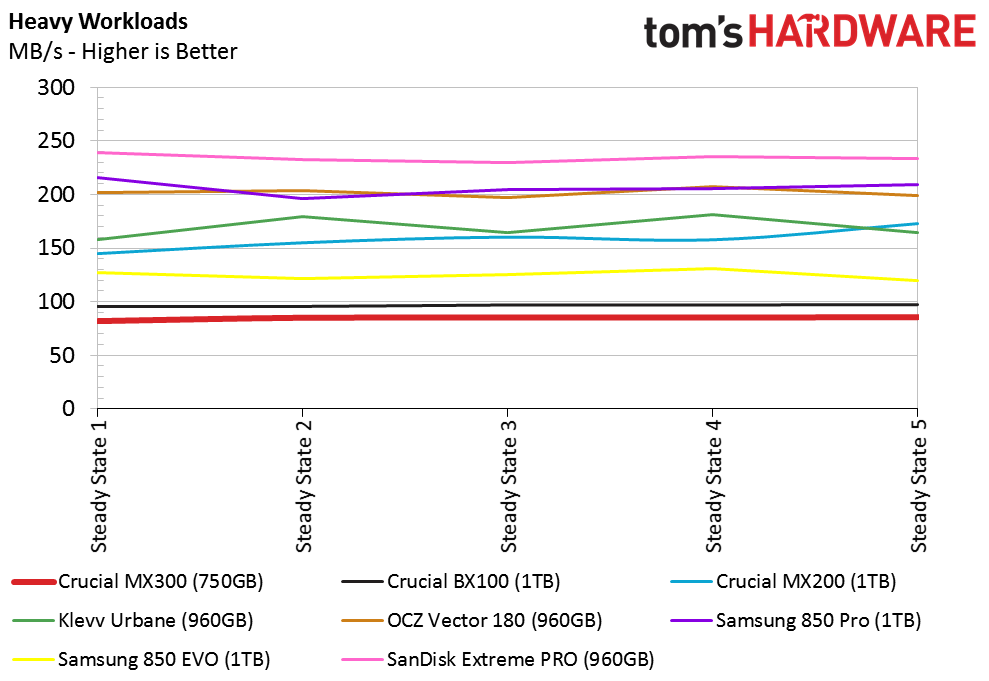
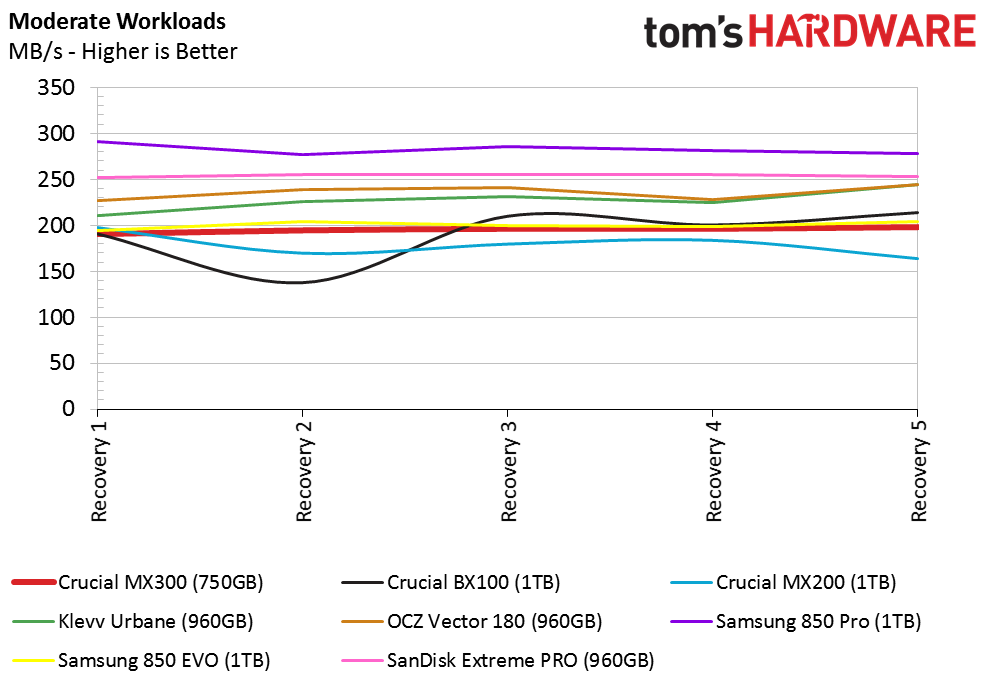
Again, we see the MX300 struggle under heavy workloads. It's too early to call Micron's new 384Gb dies a bust, but the MX300 doesn't appear to deliver the performance we expect from a mainstream-class SSD. It even continues trailing many of the other products after the test transitions to a lighter workload. The results suggest that the dynamic write acceleration technology may need more than five minutes of idle recovery time (which is what our test is programmed to allow) to be effective.
Service Time
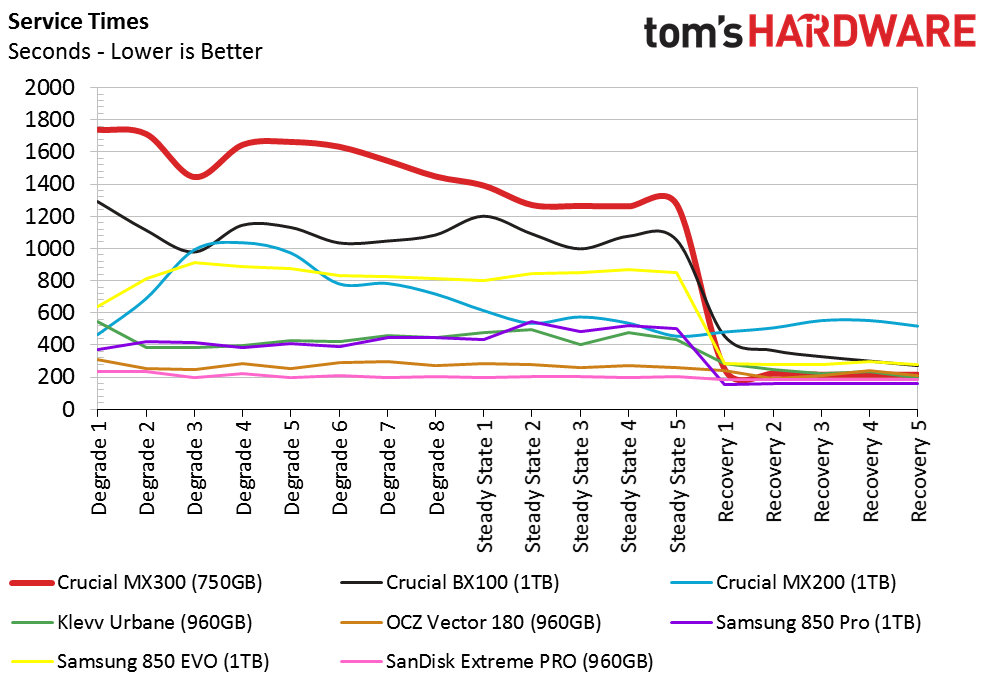
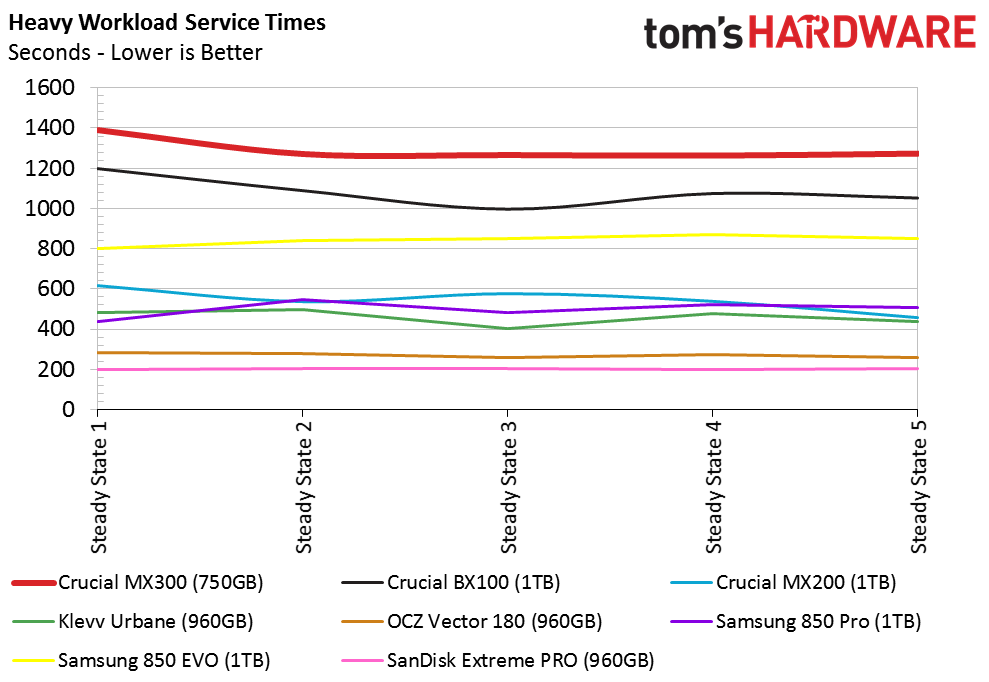
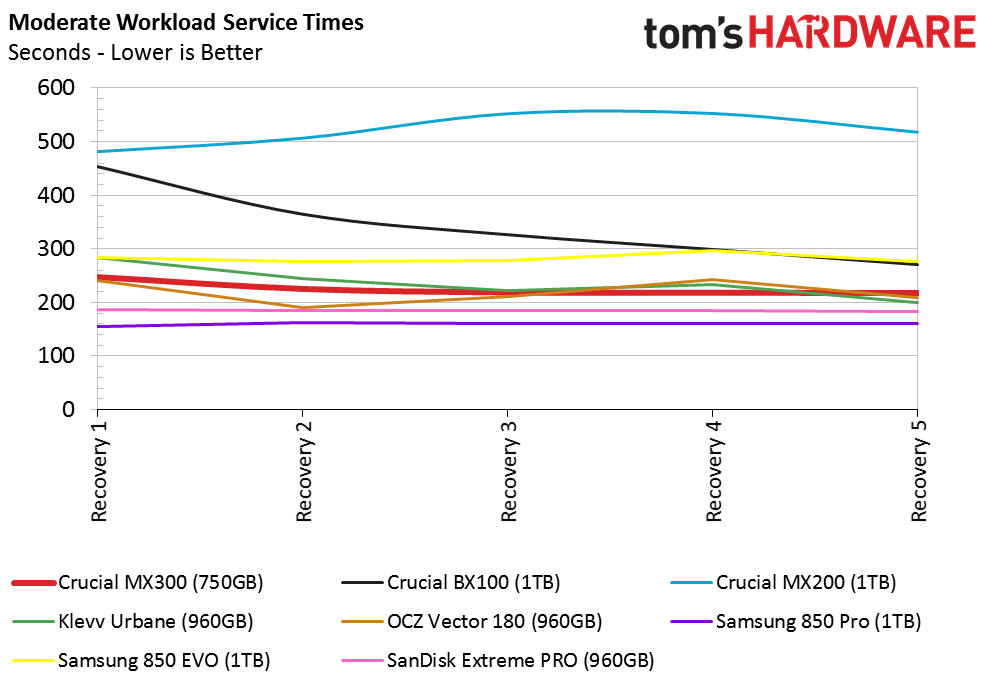
Our service time tests shed more light on the poor results. The MX300's latency becomes so bad that throughput suffers. We contacted Crucial with our findings and sent over the results. It's safe to say the company didn't expect latency numbers this high. Worse, the condition doesn't just affect benchmarks; it carries over to light office use as well.

Chris Ramseyer was a senior contributing editor for Tom's Hardware. He tested and reviewed consumer storage.
-
bit_user I've always done well with Crucial. Price per GB is competitive, even if their performance was middle of the pack.Reply
More importantly, the end-to-end error-correction offered in their MX100 and MX200 were key, for me. I don't even mind sacrificing a bit of performance, for it. I wonder if the MX300 has it? -
mapesdhs Typo in the first page, "... enthusiasts should expect more options in the 2GB+ range." - I'm assuming that should be 2TB.Reply
Pity about the performance, I had high hopes until I started seeing the results. OTOH, some do care more about capacity and price, so it may be that Samsung and others have to lower the prices anyway if Crucial can pinch some customers away.
One thing, does Crucial's modern SSD management tool allow one to do a secure erase without having to use a 3rd-party program or reboot the system? That wasn't the case with older models and was a big no thanks for me; always liked the way OCZ's tool could do a SE on the fly, and now Samsung's Magician can do that aswell (can't remember if SanDisk can).
I look forward to the death of 64GB/128GB models, they're holding things back. It'd be good if 256GB could die by the end of this year aswell, but I doubt that'll happen. -
uglyduckling81 Most people wouldn't know or care about the difference between a Sammy Evo drive and this. All they will see is the capacity and the price. Make it cheaper and they will come.Reply -
mdd1963 Any new rigs would seem incomplete without an M.2/NVMe capability, and, specifically, ...a Samsung 950 Pro and it's 2000+ MB/sec! (The rest of the SATA old school SSDs can battle over 500 vs 510 vs 550 Mb/sec, etc..)Reply -
CaedenV Reply18119633 said:Any new rigs would seem incomplete without an M.2/NVMe capability, and, specifically, ...a Samsung 950 Pro and it's 2000+ MB/sec! (The rest of the SATA old school SSDs can battle over 500 vs 510 vs 550 Mb/sec, etc..)
Perhaps for you and I, but someone like my dad would love this kind of drive. Much more space than older SSDs, while still providing much faster performance than a traditional HDD, all while keeping the price down. There may be other SSDs on the market that provide a little cheaper $/GB, but I would bet that this drive will drop in price with time to reflect how it performs compared to others. -
Sakkura This SSD should either have been that bit cheaper to really compete with the planar TLC drives, or faster to move into the 850 Evo performance tier. I'm a bit disappointed that it doesn't have that kind of performance, but more disappointed still that it's not even priced properly for its performance level.Reply
Price drops in retail can always fix that, admittedly, but there's really not much to get excited about here. I don't understand why Micron thought this was the way to introduce their shiny new 3D NAND. -
cknobman Not cheaper.Reply
Slower.
Uses more power.
No improvement on endurance.
Am I missing anything major here?
I just dont see anything that is purchase worthy here.
